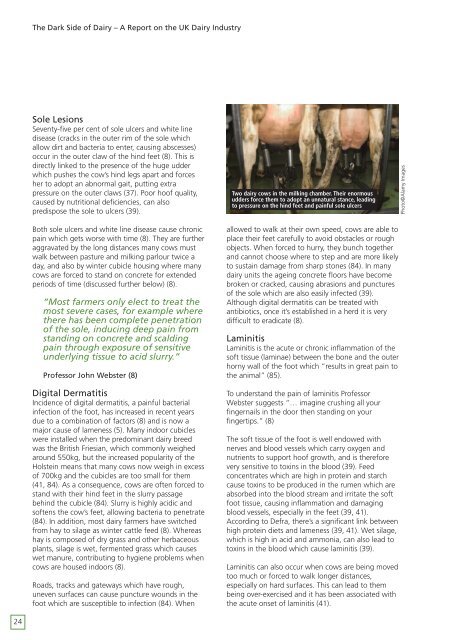You also want an ePaper? Increase the reach of your titles
YUMPU automatically turns print PDFs into web optimized ePapers that Google loves.
The <strong>Dark</strong> <strong>Side</strong> <strong>of</strong> <strong>Dairy</strong> – A Report on the UK <strong>Dairy</strong> IndustrySole LesionsSeventy-five per cent <strong>of</strong> sole ulcers and white linedisease (cracks in the outer rim <strong>of</strong> the sole whichallow dirt and bacteria to enter, causing abscesses)occur in the outer claw <strong>of</strong> the hind feet (8). This isdirectly linked to the presence <strong>of</strong> the huge udderwhich pushes the cow’s hind legs apart and forcesher to adopt an abnormal gait, putting extrapressure on the outer claws (37). Poor ho<strong>of</strong> quality,caused by nutritional deficiencies, can alsopredispose the sole to ulcers (39).Two dairy cows in the milking chamber. Their enormousudders force them to adopt an unnatural stance, leadingto pressure on the hind feet and painful sole ulcersPhoto©Alamy ImagesBoth sole ulcers and white line disease cause chronicpain which gets worse with time (8). They are furtheraggravated by the long distances many cows mustwalk between pasture and milking parlour twice aday, and also by winter cubicle housing where manycows are forced to stand on concrete for extendedperiods <strong>of</strong> time (discussed further below) (8).“Most farmers only elect to treat themost severe cases, for example wherethere has been complete penetration<strong>of</strong> the sole, inducing deep pain fromstanding on concrete and scaldingpain through exposure <strong>of</strong> sensitiveunderlying tissue to acid slurry.”Pr<strong>of</strong>essor John Webster (8)Digital DermatitisIncidence <strong>of</strong> digital dermatitis, a painful bacterialinfection <strong>of</strong> the foot, has increased in recent yearsdue to a combination <strong>of</strong> factors (8) and is now amajor cause <strong>of</strong> lameness (5). Many indoor cubicleswere installed when the predominant dairy breedwas the British Friesian, which commonly weighedaround 550kg, but the increased popularity <strong>of</strong> theHolstein means that many cows now weigh in excess<strong>of</strong> 700kg and the cubicles are too small for them(41, 84). As a consequence, cows are <strong>of</strong>ten forced tostand with their hind feet in the slurry passagebehind the cubicle (84). Slurry is highly acidic ands<strong>of</strong>tens the cow’s feet, allowing bacteria to penetrate(84). In addition, most dairy farmers have switchedfrom hay to silage as winter cattle feed (8). Whereashay is composed <strong>of</strong> dry grass and other herbaceousplants, silage is wet, fermented grass which causeswet manure, contributing to hygiene problems whencows are housed indoors (8).Roads, tracks and gateways which have rough,uneven surfaces can cause puncture wounds in thefoot which are susceptible to infection (84). Whenallowed to walk at their own speed, cows are able toplace their feet carefully to avoid obstacles or roughobjects. When forced to hurry, they bunch togetherand cannot choose where to step and are more likelyto sustain damage from sharp stones (84). In manydairy units the ageing concrete floors have becomebroken or cracked, causing abrasions and punctures<strong>of</strong> the sole which are also easily infected (39).Although digital dermatitis can be treated withantibiotics, once it’s established in a herd it is verydifficult to eradicate (8).LaminitisLaminitis is the acute or chronic inflammation <strong>of</strong> thes<strong>of</strong>t tissue (laminae) between the bone and the outerhorny wall <strong>of</strong> the foot which “results in great pain tothe animal” (85).To understand the pain <strong>of</strong> laminitis Pr<strong>of</strong>essorWebster suggests “… imagine crushing all yourfingernails in the door then standing on yourfingertips.” (8)The s<strong>of</strong>t tissue <strong>of</strong> the foot is well endowed withnerves and blood vessels which carry oxygen andnutrients to support ho<strong>of</strong> growth, and is thereforevery sensitive to toxins in the blood (39). Feedconcentrates which are high in protein and starchcause toxins to be produced in the rumen which areabsorbed into the blood stream and irritate the s<strong>of</strong>tfoot tissue, causing inflammation and damagingblood vessels, especially in the feet (39, 41).According to Defra, there’s a significant link betweenhigh protein diets and lameness (39, 41). Wet silage,which is high in acid and ammonia, can also lead totoxins in the blood which cause laminitis (39).Laminitis can also occur when cows are being movedtoo much or forced to walk longer distances,especially on hard surfaces. This can lead to thembeing over-exercised and it has been associated withthe acute onset <strong>of</strong> laminitis (41).24


